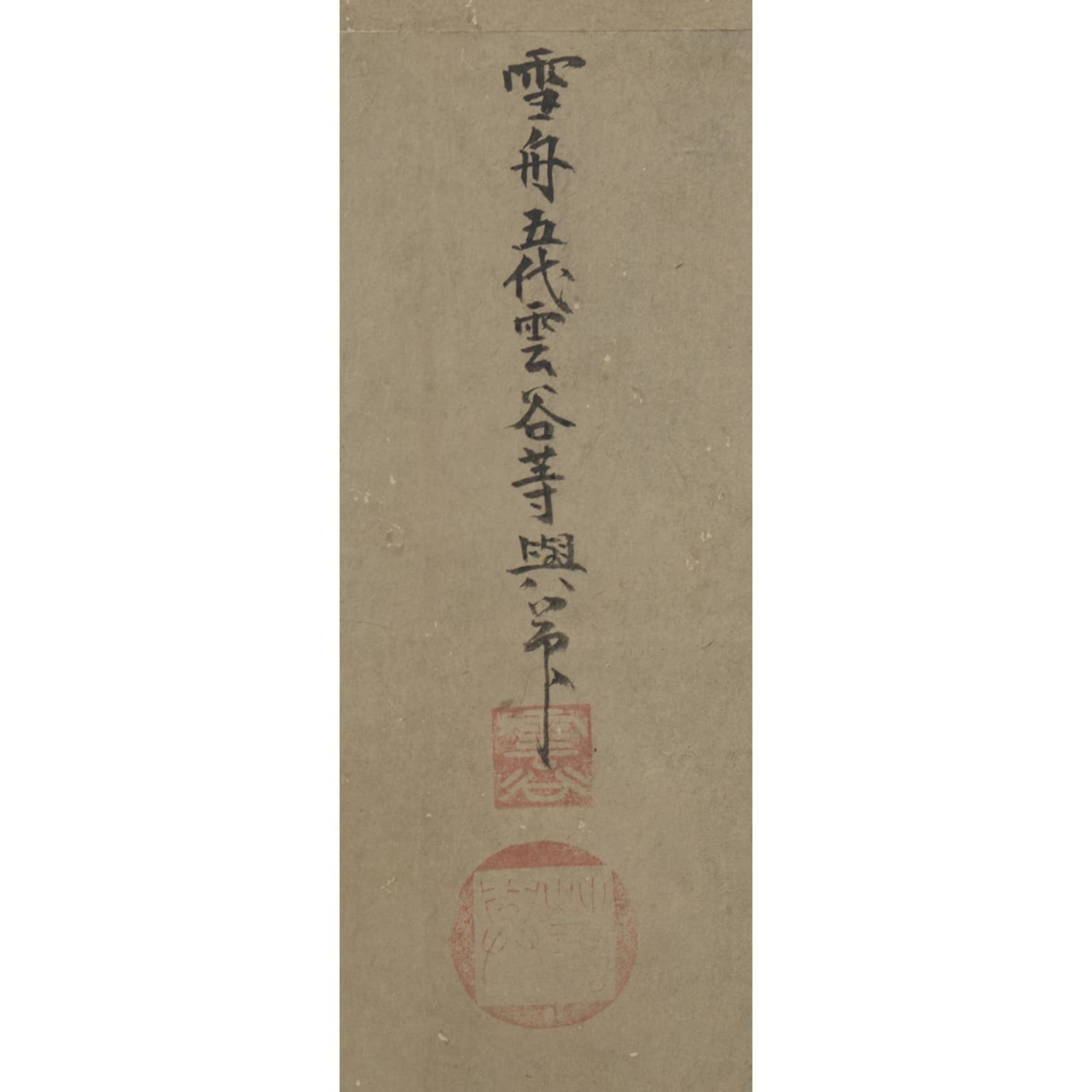Unkoku Tōyo (1612–1668)
Landscape
Ink and light color on paper, pair of six-panel folding screens
Seals: Unkoku; Toyo
165 x 370 cm each (overall)
Further images
The mountains, rocks, trees, pavilions, houses, boats, and other motifs all derive from Sesshu. More unusual is the rolling scene of mist-shrouded roofs and trees on the bottom left of the left-hand screen. This resembles scenery from Unkoku Toeki’s Landscape (Unkoku School: The Successors of Sesshu Style. Exh. cat., Plate 8), for example. On the right-hand screen, wild geese fly to the left of the central moon in a scene reminiscent of autumn. Trees resembling plum blossoms line the front right, their white-dotted blossoms alluding to early spring. The distant snow-capped mountings on the left-hand screen probably depict a winter scene. Although there is no clear summer scene, the season is perhaps represented by the sailing ships passing from the right to left screens. Either way, the artist has arranged the seasons in an irregular fashion. Paintings by the Unkoku school sometimes feature winter scenes on the right-hand screen and autumn scenes on the left-hand screen, as epitomized by Toeki’s Landscape (Kumaya Art Museum).
Painters from the Unkoku school tended to adhere closely to Sesshu’s precedent, with a sense of individuality often frowned upon. Apart from that of the school’s founder Togan, it is therefore challenging to distinguish between the style of individual members of the school, though their respective mannerisms naturally underwent small changes down the generations. The ink lines gradually became more solid, for example, and they lost their varied thickness and sense of speed in favor of a more controlled and inorganic approach. If taken too far this process could result in a sense of dullness, but particularly in the invigorating representation of the mountains on the right-hand screen the lines rely on a natural flow that is employed to great effect. The mountains are reminiscent of the landscapes Soga Shohaku painted in his later years, which suggests Shohaku was influenced by the Unkoku school.
Both screens feature the signature ‘Sesshu the Fifth Unkoku Toyo.’ Toyo’s father Unkoku Toeki called himself ‘the Fourth.’ The Unkoku family began when the feudal lord Mori Terumoto installed the painter Togan in Sesshu’s atelier Unkokuan, with Togan subsequently adopting the family name ‘Unkoku.’ Toyo was the third head of the family.
The members of the Unkoku school were retainers of the Mori clan, so art historians assume its painters were based around the Yamaguchi area, though some were also active in Kyoto. Toeki is known for the sliding door paintings he created for various subtemples of Daitokuji; Toyo likewise produced sliding door paintings for the Hekigyokuan subtemple. Together with his younger brother Toji and others, Toyo also participated in decorating the Imperial Palace after its reconstruction in 1655 (Meireki 1), and worked for Manpukuji, the head temple of the Obaku school established by the Buddhist priest Yinyuan Longqi (Jp. Ingen Ryuki) in Uji. When Yinyuan’s pupils built two new halls at Manpukuji in the honor of their master, they composed poetry to celebrate the occasion. Mounted as handscrolls, Toyo then supplied the pictures at start of these two scrolls.
Unkoku Toyo (painter; 1612–1668)
Painter from Nagato Province (modern Yamaguchi Prefecture); son of Unkoku Toeki. Toyo served as the official painter of the Mori clan and is known for the sliding door paintings of Gyokuseki’an, a subtemple of Daitokuji in Kyoto. He was awarded the Buddhist ranks of hokkyo (Dharma bridge) and hogen (Dharma eye).
Painters from the Unkoku school tended to adhere closely to Sesshu’s precedent, with a sense of individuality often frowned upon. Apart from that of the school’s founder Togan, it is therefore challenging to distinguish between the style of individual members of the school, though their respective mannerisms naturally underwent small changes down the generations. The ink lines gradually became more solid, for example, and they lost their varied thickness and sense of speed in favor of a more controlled and inorganic approach. If taken too far this process could result in a sense of dullness, but particularly in the invigorating representation of the mountains on the right-hand screen the lines rely on a natural flow that is employed to great effect. The mountains are reminiscent of the landscapes Soga Shohaku painted in his later years, which suggests Shohaku was influenced by the Unkoku school.
Both screens feature the signature ‘Sesshu the Fifth Unkoku Toyo.’ Toyo’s father Unkoku Toeki called himself ‘the Fourth.’ The Unkoku family began when the feudal lord Mori Terumoto installed the painter Togan in Sesshu’s atelier Unkokuan, with Togan subsequently adopting the family name ‘Unkoku.’ Toyo was the third head of the family.
The members of the Unkoku school were retainers of the Mori clan, so art historians assume its painters were based around the Yamaguchi area, though some were also active in Kyoto. Toeki is known for the sliding door paintings he created for various subtemples of Daitokuji; Toyo likewise produced sliding door paintings for the Hekigyokuan subtemple. Together with his younger brother Toji and others, Toyo also participated in decorating the Imperial Palace after its reconstruction in 1655 (Meireki 1), and worked for Manpukuji, the head temple of the Obaku school established by the Buddhist priest Yinyuan Longqi (Jp. Ingen Ryuki) in Uji. When Yinyuan’s pupils built two new halls at Manpukuji in the honor of their master, they composed poetry to celebrate the occasion. Mounted as handscrolls, Toyo then supplied the pictures at start of these two scrolls.
Unkoku Toyo (painter; 1612–1668)
Painter from Nagato Province (modern Yamaguchi Prefecture); son of Unkoku Toeki. Toyo served as the official painter of the Mori clan and is known for the sliding door paintings of Gyokuseki’an, a subtemple of Daitokuji in Kyoto. He was awarded the Buddhist ranks of hokkyo (Dharma bridge) and hogen (Dharma eye).





